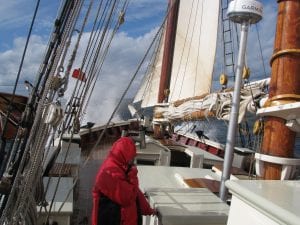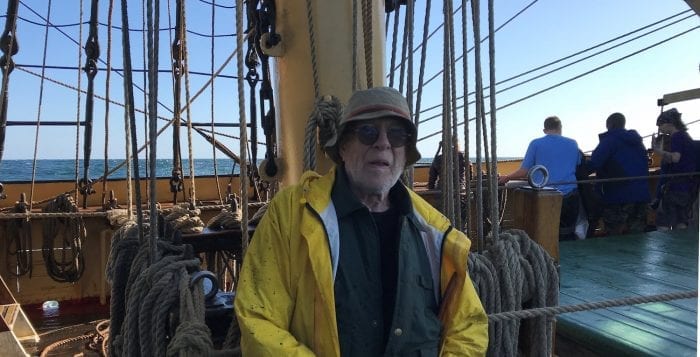History: Shipping Begins to Evolve to Meet Environmental Demands
By Beverly C. Tyler
The 19th century was the era of the romance of sail. Full-rigged ships, such as the Flying Cloud, set sail-powered speed records for ships of commerce voyaging to and from ports around the world that would never be eclipsed. These beautiful and awe-inspiring ships were just a fraction of the sailing vessels that transported goods locally, regionally and around the world.

On Long Island Sound and up and down the East Coast of America smaller cargo vessels, sloops, schooners, brigs and barks kept residents supplied with many of the products they needed to sustain life. However, today as reported in the Oct. 23 edition of The Guardian, “[Modern vessels] fan out across the seas like a giant maritime dance, a ballet of tens of thousands of vessels delivering the physical stuff that has become indispensable to our way of life: commodities and cars, white goods and gas and grains, timber and technology.
“But shipping — a vast industry that moves trillions of pounds-worth of goods each year — is facing an environmental reckoning. Ships burn the dirtiest oil, known as bunker fuel; a waste product from the refinery process, literally scraping the bottom of the barrel, the crud in crude. It’s so thick that you could walk on it at room temperature. As a result, shipping is a major polluter — responsible for about 2.5% of global carbon emissions.”
A good friend from Auckland, New Zealand, Joan Druett, is an award-winning maritime author, who has written many books about the sea including “Hen Frigates,” the stories of women in the 19th century who went to sea with their ship captain husbands. The book includes a number of Long Island women including two from Setauket. Druett also has a blog “World of the Written World.” It was through her blog that I learned of the article “Winds of change: the sailing ships cleaning up sea transport” by Nicola Cutcher in The Guardian.
There are now a number of sailing ships and maritime companies working to ship products, especially those that cannot be grown locally, to other countries in sailing vessels that have a very low carbon footprint and are environmentally responsible; in other words shipping that does not contribute to the pollution of the oceans and the air.
Companies around the world like Shipped by Sail, Timbercoast, Fairtransport, New Dawn Traders and TransOceanic Wind Transport are working to provide clean, ethical and sustainable transportation of goods.
In April of 2018, I spent a week as a crewman on the Picton Castle, a 150-foot, three-masted bark, a square-rigged sail training ship that has, as of July 2019, made seven circumnavigations of the globe. I first boarded the ship as a visitor in October 2013 in Auckland and found out that Picton Castle was then based in the Cook Islands in the Pacific. Picton Castle crew member Kate “Bob” Addison wrote these observations July 12, 2013.
“Barque Picton Castle is just twenty miles off Atiu, a raised atoll in the southern Cook Islands, the first island call of this cargo and passenger run to the outer Cook Islands. We departed from Avatiu Harbour, Rarotonga yesterday morning to start this second inter-island voyage; this time we’re heading up north to Penrhyn, Manihiki and Rakahanga after a short call at Atiu in the Southern Group. And then back to Rarotonga in August for the start of our next long South Pacific Voyage.
“These cargo and passenger operations are a fascinating chapter in the history of our ship. Running a cargo operation under sail is definitely complementary to our core mission of sail training and adventure travel, it adds depth and purpose to our experiences and provides a true hands on training opportunity on board. The ship has always been about being part of something greater than yourself, of doing things that need doing whether you feel like it or not, simply because it needs doing. And now we have pressed our barque into a service that is bigger than the ship.
“At the moment the ship’s hold is about two thirds full of cargo, about fifteen tons of which is building materials that will soon become new water tanks in Atiu. We are carrying a mother, and daughter and their dog back home to Atiu and a commercial diver up to work on the pearl farms of Manihiki. In a small way we are contributing to the workings of the Cook Islands, our home in the South Pacific.”
My week on the Picton Castle in the Gulf of Mexico, as she prepared for her last round-the-world voyage, helped me understand how dedicated the ship and crew are to teaching us, not only how to work on a sailing ship but how to be environmentally aware of our surroundings and how important it is to respect the seas and harbors where we work and live.
In 2008 my wife and I spent a few days on the Stephen Taber, an 1872 Long Island-built schooner in Penobscot Bay in Maine. During the week we had a lobster and clam bake on one of the uninhabited off-shore Islands. We were told not to collect any driftwood. We brought everything we needed to the beach including the wood for the fire and when we left everything we brought was removed as if we had never been there. I am thankful for what these experiences have taught me.
Beverly C. Tyler is Three Village Historical Society historian and author of books available from the society at 93 North Country Road, Setauket. For more information, call 631-751-3730 or visit www.tvhs.org.







